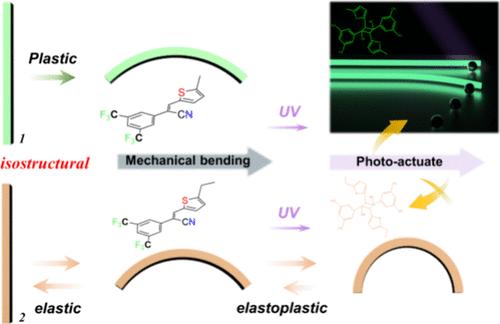同结构但化学性质不同的分子晶体致动器具有不同的机械特性和光机械响应
IF 7
2区 材料科学
Q2 CHEMISTRY, PHYSICAL
引用次数: 0
摘要
解读晶体堆积和分子间相互作用的微小变化对机械运动类型和幅度的影响,是操纵动态晶体作为智能材料的宏观动态行为的核心。在这里,我们描述了一个奇特的例子,即分子晶体中的机械柔性和光机械运动都可以通过单个微小的化学置换而改变。具体来说,我们证明了通过将噻吩环上的一个官能团从甲基(晶体 1)变为乙基(晶体 2),有机晶体的机械柔性就会从塑性弯曲转变为弹性/塑性弯曲,但它们的晶体结构几乎完全相同。不同的分子堆积也决定了[2 + 2]光环加成反应的速率,这进一步反映了光机械效应的类型:晶体 1 在紫外线照射下会发生弯曲或卷曲,具体取决于晶体的厚度,而晶体 2 则不会显示出宏观的光机械反应。晶体 1 的弯曲最多可重复 30 次,这种变形可用于移动质量为晶体 103-104 倍的物体,输出力密度为 107-108 N/m3,输出功密度为 102-103 J/m3,超过了各种传统致动器。本文章由计算机程序翻译,如有差异,请以英文原文为准。

Distinct Mechanical Properties and Photomechanical Response from Isostructural, yet Chemically Different Molecular Crystal Actuators
Deciphering the effect of small changes in crystal packing and intermolecular interactions on the type and magnitude of mechanical motion is central to the manipulation of the macrodynamic behavior of dynamic crystals as smart materials. Here, we describe a peculiar example where both the mechanical flexibility and the photomechanical motion in molecular crystals can be altered by a single small chemical substitution. Specifically, we demonstrate that the mechanical flexibility of an organic crystal switches from plastic bending to elastic/plastic bending by changing a single functional group of a thiophene ring from methyl (crystal 1) to ethyl (crystal 2), but they have an almost identical crystal structure. The different molecular packing also determines the rate of the [2 + 2] photocycloaddition reaction, which further reflects on the type of photomechanical effect: while upon UV radiation, crystals 1 undergo bending or coiling, depending on the crystal thickness, crystals 2 do not display macroscopic photomechanical response. The bending of crystals 1 can be repeated up to 30 times, and this deformation can be applied to move objects that are 103–104 times the mass of the crystals with an output force density of 107–108 N/m3 and output work density of 102–103 J/m3, surpassing a variety of traditional actuators.
求助全文
通过发布文献求助,成功后即可免费获取论文全文。
去求助
来源期刊

Chemistry of Materials
工程技术-材料科学:综合
CiteScore
14.10
自引率
5.80%
发文量
929
审稿时长
1.5 months
期刊介绍:
The journal Chemistry of Materials focuses on publishing original research at the intersection of materials science and chemistry. The studies published in the journal involve chemistry as a prominent component and explore topics such as the design, synthesis, characterization, processing, understanding, and application of functional or potentially functional materials. The journal covers various areas of interest, including inorganic and organic solid-state chemistry, nanomaterials, biomaterials, thin films and polymers, and composite/hybrid materials. The journal particularly seeks papers that highlight the creation or development of innovative materials with novel optical, electrical, magnetic, catalytic, or mechanical properties. It is essential that manuscripts on these topics have a primary focus on the chemistry of materials and represent a significant advancement compared to prior research. Before external reviews are sought, submitted manuscripts undergo a review process by a minimum of two editors to ensure their appropriateness for the journal and the presence of sufficient evidence of a significant advance that will be of broad interest to the materials chemistry community.
 求助内容:
求助内容: 应助结果提醒方式:
应助结果提醒方式:


